Citroën Jumpy-Dispatch (2022 year). Manual in english — page 10
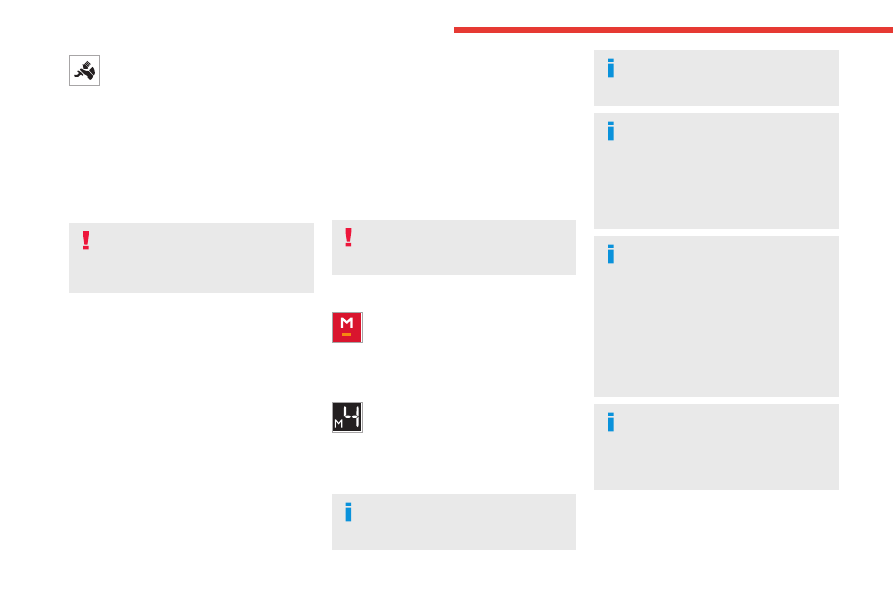
146
Driving
► For maximum acceleration without
touching the selector, fully depress the
accelerator pedal (kick-down).
The gearbox changes down automatically or
holds the gear selected until the maximum
engine speed is reached.
When braking, the gearbox changes down
automatically to provide effective engine braking.
If you release the accelerator sharply, the
gearbox will not shift to a higher gear for safety
reasons.
Never select position
N
while the vehicle
is moving.
Never select positions
P
or
R
unless the
vehicle is completely stationary.
Temporary manual control
of gear changes
You can temporarily assume control of gear
changing using the "
+
" et "
-
” steering-mounted
controls. The gear change request will be
executed if the engine speed permits.
This function allows you to anticipate certain
situations, such as overtaking another vehicle or
approaching a bend in the road.
After a few seconds with no inputs via the control
paddles, the gearbox reverts to automatic
operation.
Creeping (moving without
using the accelerator)
This function facilitates manoeuvring of the
vehicle at low speed (when parking, in traffic
jams, etc.).
With the engine at idle, parking brake released
and position
D
,
M
or
R
selected, the
vehicle
moves
as soon as you take your foot off
the brake pedal (even without pressing the
accelerator).
As a safety precaution, never leave the
vehicle with the engine running and the
doors closed.
Manual operation
► With the selector in position
D
, press
button
M
to enable 6- or 8-speed
sequential
gear changing.
The indicator lamp for the button comes on.
► Operate the "
+
" or "
-
" steering mounted
controls.
M
appears and the engaged gears are
shown in succession on the instrument
panel.
► You can revert to automatic operation at any
time by pressing button
M
again.
The indicator lamp for the button goes off.
In manual mode, there is no need to
release the accelerator pedal while
changing gear.
It is only possible to change from one
gear to another if the vehicle speed and
engine speed permit.
If the engine speed is too low or too high,
the selected gear flashes for a few
seconds, then the gear actually engaged is
shown.
When the vehicle is stationary or moving very
slowly, the gearbox automatically selects gear
M1
.
To preserve the brakes while descending
a steep incline, use engine braking to
reduce your speed (change down or select a
lower gear).
Keeping the brake pedal pressed
continuously for long periods can overheat
the brakes, with the risk of damaging the
braking system or making it inoperative.
Only use the brakes when necessary, to slow
or stop the vehicle.
Depending on the road configuration
(e.g. mountainous road), manual
operation may be preferable.
Automatic operation may not always be
suitable, and does not enable engine braking.
-------------------------------------------------------------------------------------------------------------------------------------------------------------

147
Driving
6
Invalid value during manual
operation
This symbol is displayed if a gear is not
engaged correctly (gear selector between
two positions).
► Place the selector "correctly" at a position.
Switching off the vehicle
Before switching off the engine, select position
P
then apply the parking brake to immobilise
the vehicle, unless this is set to automatic mode
(with electric parking brake).
Check that mode
P
has been engaged and that
the electric parking brake has been applied
automatically; if not, apply it manually.
The corresponding indicator lamps in the
selector and the electric parking brake control
lever must be on, as well as those on the
instrument panel.
A point of resistance may be noticed
when moving to position
P
.
If the selector is not in position
P
, when the
driver's door is opened or approximately 45
seconds after the ignition is switched off,
an audible signal sounds and a message
appears.
► Return the drive selector to position
P
;
the audible signal stops and the message
disappears.
When positioned on a steep slope with a
loaded vehicle,
depress the brake
pedal
, select position
P
, apply the parking
brake, unless it is set to automatic mode (with
electric parking brake), then release the brake
pedal.
In all circumstances, ensure that the
selector is in position
P
before leaving
your vehicle.
Malfunction
When the ignition is on, a message appears on
the instrument panel to indicate a fault with the
gearbox.
In this case, the gearbox goes into back-up
mode and is locked in 3
rd
gear. You may feel a
significant jolt (without risk to the gearbox) when
changing from
P
to
R
and from
N
to
R
.
Do not exceed 62 mph (100 km/h), local speed
restrictions permitting.
Have it checked by a CITROËN dealer or a
qualified workshop.
There is a risk of damaging the gearbox:
– If the accelerator and brake pedals are
depressed simultaneously.
– In the event of a battery failure, forcing the
selector from position
P
to another position.
If your vehicle has an automatic gearbox,
do not try to start the engine by pushing
the vehicle.
Drive selector (Electric)
The drive selector is a pulse selector with a
regenerative braking function.
The drive selector provides traction control
based on the driving style, the road profile and
the vehicle load.
With regenerative braking activated, it also
manages engine braking when the accelerator
pedal is released.
P.
Park
Button for parking the vehicle: the front
wheels are locked (the button lights up to
indicate that it is activated).
R.
Reverse
To engage reverse gear, with your foot on the
brake pedal.
-------------------------------------------------------------------------------------------------------------------------------------------------------------
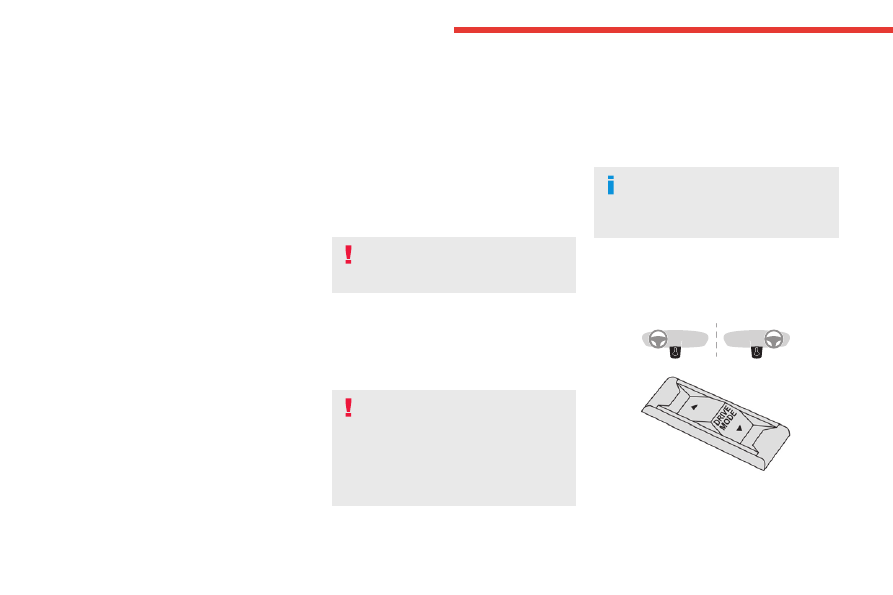
148
Driving
N.
Neutral
To move the vehicle with the ignition off and
so allow it to free-wheel.
For more information on
Free-wheeling
, refer
to the corresponding section.
D.
Drive (automatic forward gear)
B.
Brake (regenerative braking)
Regenerative braking (the button lights up to
indicate its activation).
Information displayed on
the instrument panel
When the ignition is switched on, the drive
selector status is displayed on the instrument
panel:
P
: Park.
R
: Reverse.
N
: Neutral.
D
: Drive (automatic forward gear).
B
: Brake (regenerative braking activated).
Operation
► Move the selector by pressing it forwards
(
N
or
R
) or rearwards (
N
or
D
) once or twice,
passing the point of resistance if necessary.
For example, to change from
P
to
R
(with your
foot on the brake pedal), either push forwards
twice without passing the point of resistance or
push just once, passing the point of resistance.
Regenerative braking
With the Brake function and when
decelerating
The Brake function emulates engine braking,
slowing the vehicle with no need to depress the
brake pedal. The vehicle slows more quickly
when the driver releases the accelerator pedal.
The energy recovered when the accelerator
pedal is released is then used to partially
recharge the traction battery, thereby increasing
the vehicle's driving range.
The resulting deceleration of the vehicle
does not cause the brake lamps to come
on.
► From mode
D
, press button
B
to activate/
deactivate the function (the button lights up when
the function is activated).
D
on the instrument panel is replaced with
B
.
The status of the function is saved when the
ignition is switched off.
In some situations (e.g. battery full,
extreme temperatures), the amount of
regenerative braking may be temporarily
limited, resulting in less deceleration.
The driver must remain alert to traffic
conditions and must always be ready to use
the brake pedal.
With the brake pedal
When the brake pedal is depressed, the
intelligent braking system automatically recovers
some of the energy and uses it to recharge the
traction battery.
This energy recovery also reduces use of the
brake pads, thereby limiting their wear.
The driver may experience a different
sensation when depressing the brake
pedal compared to a vehicle without
regenerative braking.
Driving modes (Electric)
Driving modes are selected using the following
control:
► Press the control to display the modes on the
instrument panel, and depending on version, on
the screen with MyCitroën Drive.
-------------------------------------------------------------------------------------------------------------------------------------------------------------
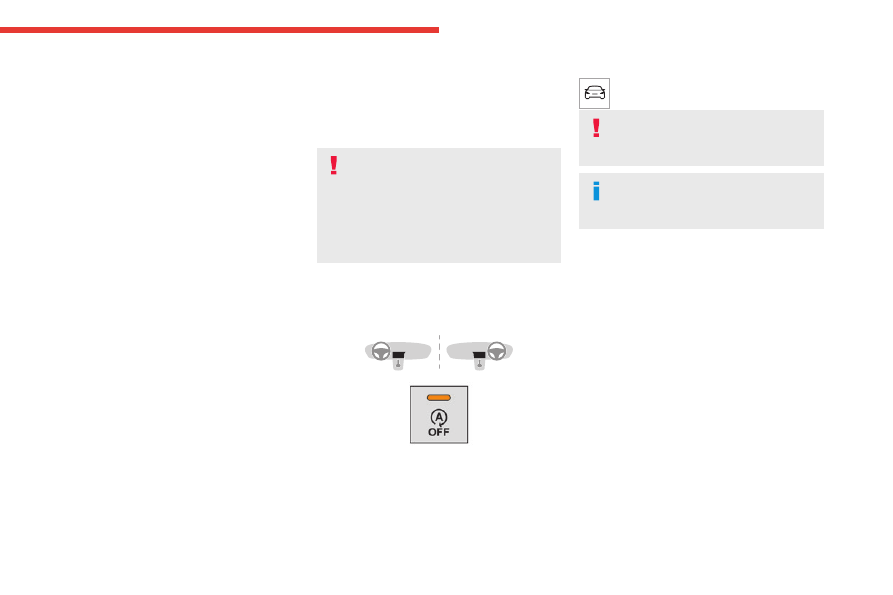
149
Driving
6
When starting the vehicle, no mode can be
selected until the
READY
indicator lamp is
displayed.
When the message disappears, the selected
mode is activated and remains indicated on the
instrument panel (except
Normal
mode).
Each time the ignition is switched on,
Normal
mode is selected by default.
Normal
This optimises the driving range and dynamic
performance.
To obtain maximum torque and power, depress
the accelerator pedal fully.
Eco
Optimises energy consumption, by reducing
the output of the heating and air conditioning
(without actually deactivating them) and limiting
both motor torque and power.
Power
Provides equivalent vehicle performance when
fully laden (GVW) to when the vehicle is in
Normal mode and when unladen.
Stop & Start
The Stop & Start function puts the engine
temporarily into standby - STOP mode - during
phases when the vehicle is stationary (e.g. red
lights, traffic jams). The engine automatically
restarts - START mode - as soon as the driver
indicates the intention of moving off again.
Primarily designed for urban use, the function
is intended to reduce fuel consumption and
exhaust emissions as well as the noise level
when stationary.
The function does not affect the functionalities of
the vehicle, in particular the braking.
Driving on flooded roads
Before entering into a flooded area, it is
strongly recommended that you deactivate
the Stop & Start system.
For more information on
Driving
recommendations
, particularly on flooded
roads, refer to the corresponding section.
Deactivation/Reactivation
With audio system
► To deactivate or reactivate the system, press
this button.
The indicator lamp is
on
when the system is
deactivated
.
With touch screen
The settings are changed via the vehicle
configuration menu.
If the system has been deactivated in
STOP mode, the engine restarts
immediately.
The system is reactivated automatically
whenever the engine is started by the
driver.
Operation
Main conditions for operation
– The driver’s door must be closed.
– The sliding side door must be closed.
– The driver's seat belt must be fastened.
– The level of charge in the battery must be
sufficient.
– The temperature of the engine must be within
its nominal operating range.
– The outside temperature must be between
0°C and 35°C.
Putting the engine into standby
(STOP mode)
The engine automatically enters standby mode
as soon as the driver indicates their intention to
stop:
With a
manual gearbox
: at speeds below 12
mph (20 km/h) or with the vehicle stationary
-------------------------------------------------------------------------------------------------------------------------------------------------------------
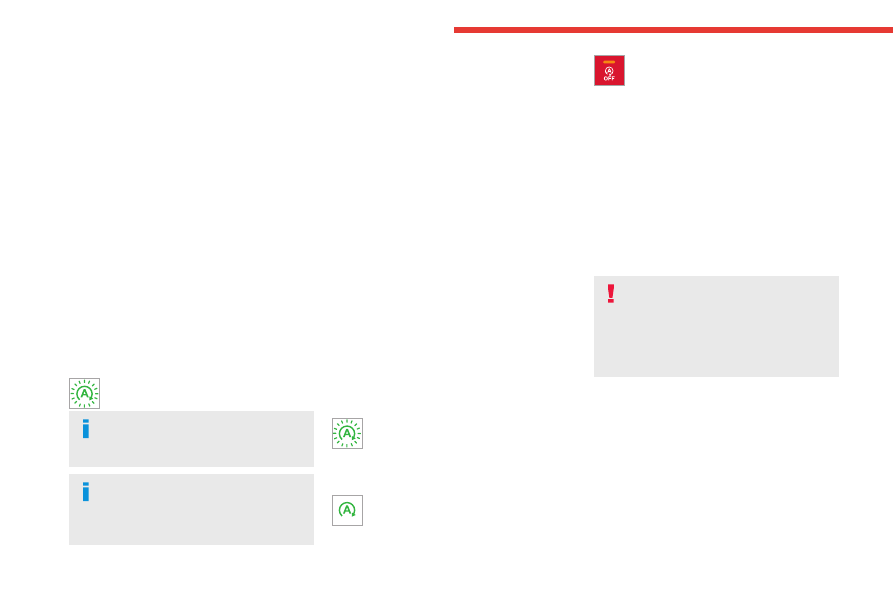
150
Driving
(depending on engine), with the gear lever in
neutral and the clutch pedal released.
With an
automatic gearbox
: with the brake
pedal depressed or the gear selector in
position
N
, with the vehicle stationary.
Time counter
A time counter adds up the time spent in standby
during the journey. It is reset to zero every time
the ignition is switched on.
Special cases:
The engine will not go into standby if the
conditions for operation are not met and in the
following cases:
– Steep slope (ascending or descending).
– Vehicle has not exceeded 6 mph (10 km/h)
since the last engine start (with the key or the
START/STOP
button).
– Needed to maintain a comfortable temperature
in the passenger compartment.
– Demisting active.
In these cases, this indicator lamp flashes
for a few seconds, then goes off.
After the engine has restarted, STOP
mode is not available until the vehicle
has reached a speed of 5 mph (8 km/h).
During parking manoeuvres, STOP mode
is not available for a few seconds after
coming out of reverse gear or turning the
steering wheel.
Restarting the engine (START mode)
The engine automatically restarts as soon as the
driver indicates the intention of moving off again:
With a manual gearbox
: with the clutch pedal
fully depressed.
With an automatic gearbox
:
– With the selector in position
D
or
M
: with the
brake pedal released.
– With the selector in position
N
and the brake
pedal released: with the selector at
D
or
M
.
– With the selector in position
P
and the brake
pedal depressed: with the selector at
R
,
N
,
D
or
M
.
– Reverse gear engaged.
Special cases
The engine will restart automatically if the
conditions for operation are met again and in the
following cases:
– With a
manual gearbox
: vehicle speed
exceeds 16 mph (25 km/h) or 2 mph (3 km/h)
(depending on engine).
– With an
automatic gearbox
, vehicle speed
exceeds 2 mph (3 km/h).
In these cases, this indicator lamp flashes
for a few seconds, then goes off.
Malfunctions
Depending on the vehicle’s equipment:
In the event of a system malfunction, this
warning lamp flashes on the instrument
panel.
The warning lamp in this button flashes
and a message appears, accompanied by
an audible signal.
Have it checked by a CITROËN dealer or a
qualified workshop.
The vehicle stalls in STOP mode
All of the instrument panel warning lamps come
on if there is a fault.
Depending on version, a warning message
may also be displayed, prompting you to place
the gear selector in position
N
and depress the
brake pedal.
► Switch off the ignition then start the engine
again with the key or the "
START/STOP
" button.
12 V battery
The Stop & Start system requires a
12 V battery of specific technology and
specification.
All work must be carried out only by a
CITROËN dealer or a qualified workshop
Tyre
under-inflation
detection
This system automatically checks the pressures
of the tyres while driving.
It compares the information given by the wheel
speed sensors with
reference values, which
must be reinitialised every time the tyre
pressures are adjusted or a wheel changed
.
-------------------------------------------------------------------------------------------------------------------------------------------------------------
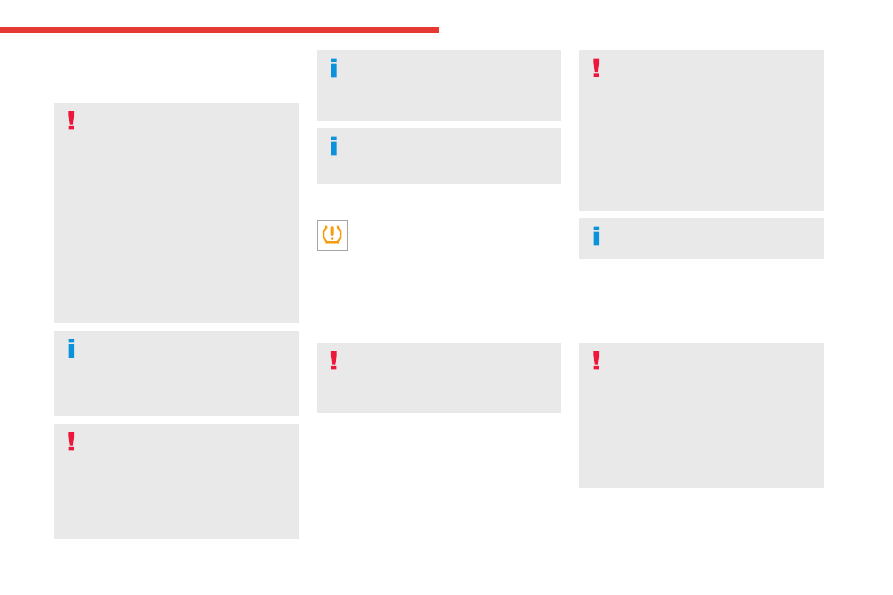
151
Driving
6
The system triggers an alert as soon as it
detects a drop in the inflation pressure of one or
more tyres.
Under-inflation detection does not
replace the need for vigilance on the part
of the driver.
This system does not avoid the need to
regularly check the tyre pressures (including
the spare wheel) as well as before a long
journey.
Driving with under-inflated tyres, particularly
in adverse conditions (heavy load, high
speed, long journey):
– worsens road-holding,
– lengthens braking distances,
– causes premature wear of the tyres,
– increases fuel consumption.
The inflation pressures specified for the
vehicle can be found on the tyre pressure
label.
For more information on the
Identification
markings
, refer to the corresponding section.
Checking tyre pressures
This check should be done when the
tyres are "cold" (vehicle stopped for 1 hour or
after a journey of less than 6 miles (10 km) at
moderate speeds).
Otherwise, add 0.3 bar to the pressures
shown on the label.
Snow chains
The system does not have to be
reinitialised after fitting or removing snow
chains.
Spare wheel
The steel spare wheel does not have an
under-inflation detection sensor.
Under-inflation alert
This is signalled by the fixed illumination
of this warning lamp, accompanied by an
audible signal and, depending on equipment, the
display of a message.
► Reduce speed immediately, avoid excessive
steering movements and avoid sudden braking.
► Stop the vehicle as soon as it is safe to do
so.
The loss of pressure detected may not
always cause visible deformation of the
tyre.
Do not rely on just a visual check.
► Using a compressor, such as the one in
the temporary puncture repair kit, check the
pressures of all four tyres when cold.
► If it is not possible to carry out this check
immediately, drive carefully at reduced speed.
► In the event of a puncture, use the
temporary puncture repair kit or the spare wheel
(depending on equipment).
Driving too slowly may not ensure
optimum monitoring.
The alert is not immediately triggered in the
event of a sudden loss of pressure or tyre
blow-out. This is because analysis of the
values read by the wheel's speed sensors
can take several minutes.
The alert may be delayed at speeds below
25 mph (40 km/h), or when adopting a sporty
driving mode.
The alert is kept active until the system is
reinitialised.
Reinitialisation
► The system must be reinitialised after any
adjustment to the pressure of one or more tyres,
and after changing one or more wheels.
Before reinitialising the system, make
sure that the pressures of the four tyres
are correct for the conditions of use of the
vehicle and conform to the values written on
the tyre pressure label.
Check the pressures of the four tyres before
performing the reinitialisation.
The system does not advise if a pressure is
incorrect at the time of reinitialisation.
-------------------------------------------------------------------------------------------------------------------------------------------------------------

152
Driving
With dashboard button
► With the vehicle stationary, press this
button for about 3 seconds then release it.
Reinitialisation is confirmed by an audible signal.
Without dashboard button
With the vehicle stationary, the
system is reinitialised via the
vehicle configuration menu.
Malfunction
In the event of a malfunction,
these warning lamps light up on
the instrument panel.
In this case, the tyre under-inflation monitoring
function is no longer performed.
Have it checked by a CITROËN dealer or a
qualified workshop.
Driving and manoeuvring
aids - General
recommendations
Driving and manoeuvring aids cannot, in
any circumstances, replace the need for
vigilance on the part of the driver.
The driver must comply with the Highway
Code, must remain in control of the vehicle in
all circumstances and must be able to retake
control of it at all times. The driver must adapt
the speed to climatic conditions, traffic and
the state of the road.
It is the driver's responsibility to constantly
monitor traffic conditions, assess the distance
and relative speed of other vehicles, and
anticipate their manoeuvres before using the
direction indicator and changing lanes.
These systems do not make it possible to
exceed the laws of physics.
Driving aids
You should hold the steering wheel with
both hands, always use the door and interior
mirrors, always leave your feet close to the
pedals and take a break every 2 hours.
Manoeuvring aids
The driver must always check the
surroundings of the vehicle before and during
the whole manoeuvre, in particular using the
mirrors.
Radar(s)
The operation of the radar(s), along with
any associated functions, may be affected
by the accumulation of dirt (e.g. mud, ice),
in poor weather conditions (e.g. heavy rain,
snow), or if the bumpers are damaged.
If the front bumper is to be repainted, contact
a CITROËN dealer or a qualified workshop;
certain types of paint could interfere with the
operation of the radar(s).
Driving aids camera
This camera and its associated functions
may be impaired or not work if the windscreen
area in front of the camera is dirty, misty,
frosty, covered with snow, damaged or
masked by a sticker.
In humid and cold weather, demist the
windscreen regularly.
Poor visibility (inadequate street lighting,
heavy rain, thick fog, snowfall), dazzle
(headlamps of an oncoming vehicle, low sun,
reflections on a damp road, leaving a tunnel,
alternating shade and light) can also impair
detection performance.
-------------------------------------------------------------------------------------------------------------------------------------------------------------
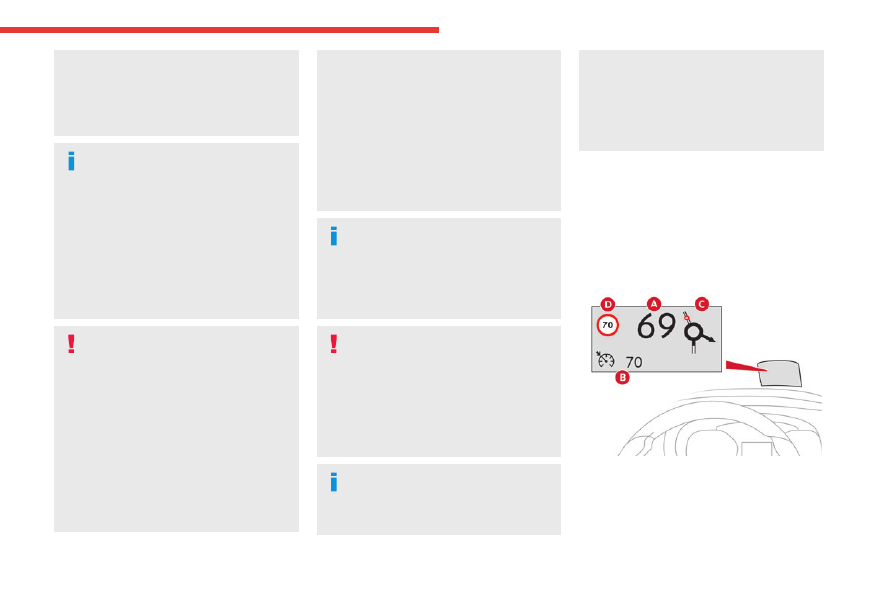
153
Driving
6
In the event of a windscreen replacement,
contact a CITROËN dealer or a qualified
workshop to recalibrate the camera;
otherwise, the operation of the associated
driving aids may be disrupted.
Other cameras
The images from the camera(s)
displayed on the touch screen or on the
instrument panel may be distorted by the
terrain.
In the presence of areas in shade, or in
conditions of bright sunlight or inadequate
lighting, the image may be darkened and with
lower contrast.
Obstacles may appear further away than they
actually are.
Sensors
The operation of the sensors, as well as
any associated functions, may be disrupted
by noise pollution such as that emitted by
noisy vehicles and machinery (e.g. lorries,
pneumatic drills), by the accumulation of
snow or dead leaves on the road or in the
event of damaged bumpers and mirrors.
When reverse gear is engaged, an audible
signal (long beep) indicates that the sensors
may be dirty.
A front or rear impact to the vehicle can
upset the sensors’ settings, which is not
always detected by the system: distance
measurements may be distorted.
The sensors do not systematically detect
obstacles that are too low (pavements, studs)
or too thin (trees, posts, wire fences).
Certain obstacles located in the sensors’ blind
spots may not be detected or may no longer
be detected during the manoeuvre.
Certain materials (fabrics) absorb sound
waves: pedestrians may not be detected.
Maintenance
Clean the bumpers and door mirrors and
the field of vision of the cameras regularly.
When washing your vehicle at high pressure,
direct the spray from at least 30 cm away
from the radar, sensors and cameras.
Mats/Pedal trims
The use of mats or pedal trims not
approved by CITROËN may interfere with
the operation of the speed limiter or cruise
control.
To avoid any risk of jamming the pedals:
– Ensure that the mat is secured correctly.
– Never fit one mat on top of another.
Units of speed
Ensure that the units of speed displayed
on the instrument panel (mph or km/h) are
those for the country you are driving in.
If this is not the case, when the vehicle is
stationary, set the display to the required
units of speed so that it complies with what is
authorised locally.
In case of doubt, contact a CITROËN dealer
or a qualified workshop.
Head-up display
System which projects various information onto a
smoked blade placed in the driver's field of vision
to avoid the driver having to take their eyes off
the road.
Display in operation
Once the system has been activated, the
following information is grouped together in the
head-up display:
A.
The speed of the vehicle.
B.
Cruise control/speed limiter information.
-------------------------------------------------------------------------------------------------------------------------------------------------------------
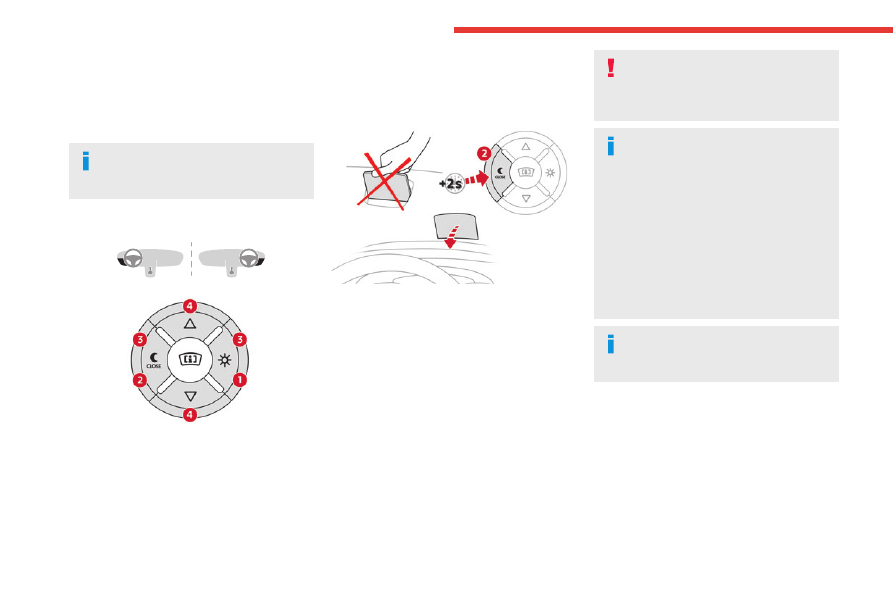
154
Driving
C.
If the vehicle is so equipped, inter-vehicle
distance information, automatic emergency
braking alerts and navigation instructions.
D.
If the vehicle is so equipped, speed limit
information.
For more information about
Navigation
,
refer to the sections describing the audio
and telematics systems.
Selectors
1.
On.
2.
Off (long press).
3.
Brightness adjustment.
4.
Display height adjustment.
Activation/Deactivation
► With the engine running, press button
1
to
activate the system and deploy the projection
blade.
► Press and hold button
2
to deactivate the
system and retract the projection blade.
The state of the system is saved when the
engine is switched off and restored on restarting.
Adjusting the height
► With the engine running, adjust the display to
the desired height using the buttons
4
:
• up to move the display up,
• down to move the display down.
Brightness adjustment
► With the engine running, adjust the
brightness of the information display using the
buttons
3
:
• on the "sun" to increase the brightness,
• on the "moon" to decrease the brightness.
When stationary or while driving, no
objects should be placed around the
projection blade (or in its recess) so as not to
impede its movement and correct operation.
In certain extreme weather conditions
(rain and/or snow, bright sunshine, etc.),
the head-up display may not be legible or
may suffer temporary interference.
Some sunglasses may hamper reading of the
information.
To clean the projection blade, use a clean,
soft cloth (such as a spectacles cloth or
microfibre cloth). Do not use a dry or abrasive
cloth, or detergent or solvent products, due to
the risk of scratching the projection blade or
damaging the non-reflective coating.
This system operates when the engine is
running, and the settings are saved when
the ignition is switched off.
Memorising speeds
This function allows you to save speed
settings which are then used to set the two
systems: the speed limiter (limits the speed
of the vehicle) or cruise control (vehicle
cruising speed).
You can save 6 speed settings for each of the
two systems.
-------------------------------------------------------------------------------------------------------------------------------------------------------------

155
Driving
6
Programming
The speed thresholds can be set in the
vehicle configuration menu using the
touch screen.
► Select the system for which you want to
memorise new speed settings:
– speed limiter
or
– cruise control.
► Press the button corresponding to the speed
setting you want to change.
► Enter the new value using the numerical
keypad and confirm.
► Confirm to record the changes and quit the
menu.
Memorised speeds are recalled
by pressing this button.
Road signs recognition
For more information, refer to the
General recommendations on the use
of driving and manoeuvring aids
.
This system displays the maximum speed
authorised locally on the instrument panel, using:
– Speed limit signs detected by the camera.
– Speed limit information from the navigation
system’s mapping.
Navigation mapping should be regularly
updated in order to receive accurate
speed limit information from the system.
The units for the speed limit (mph or
km/h) depend on the country you are
driving in.
This should be taken into account to ensure
you observe the speed limit.
For the system to work properly when
changing countries, the speed unit of the
instrument panel must match that of the
country you are driving in.
Automatic sign reading is a driving aid
system and does not always display the
correct speed limits.
The speed limit signs present on the road
always take priority over those displayed by
the system.
The system is designed to detect signs that
conform to the Vienna Convention on road
signs.
Activation/Deactivation
The settings are changed via the
vehicle configuration menu.
Information displayed on
the instrument panel
-------------------------------------------------------------------------------------------------------------------------------------------------------------
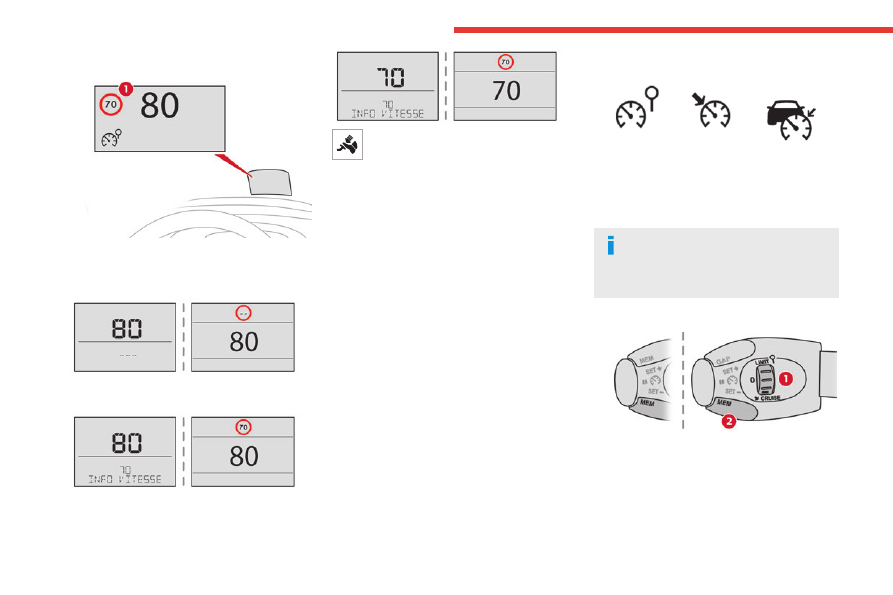
156
Driving
Head-up display
1.
Speed limit indication
Speed display
The system is active but is not detecting speed
limit information.
On detection of speed limit information, the
system displays the value.
The driver can, if desired, adjust the
speed of the vehicle according to the
information given by the system.
Operating limits
The system does not take account of reduced
speed limits, especially those imposed in the
following cases:
– Poor weather (rain, snow).
– Atmospheric pollution.
– Towing.
– Driving with a space-saver type spare wheel
or snow chains fitted.
– Tyre repaired using the temporary puncture
repair kit.
– Young drivers.
The system may not display the speed limit if it
does not detect a speed limit sign within a preset
period and in the following situations:
– Road signs that are obstructed, non-standard,
damaged or bent.
– Obsolete or incorrect maps.
Storing the speed setting
In addition to
Road signs recognition
, the
driver can select the speed displayed as a speed
setting for the speed limiter or cruise control
using the speed limiter or cruise control 'store'
button.
For more information on the
Speed
limiter
,
Cruise control
or
Adaptive
cruise control
, refer to the corresponding
sections.
Steering-mounted controls
1.
Speed limiter/cruise control mode selection
2.
Memorise the speed setting
-------------------------------------------------------------------------------------------------------------------------------------------------------------
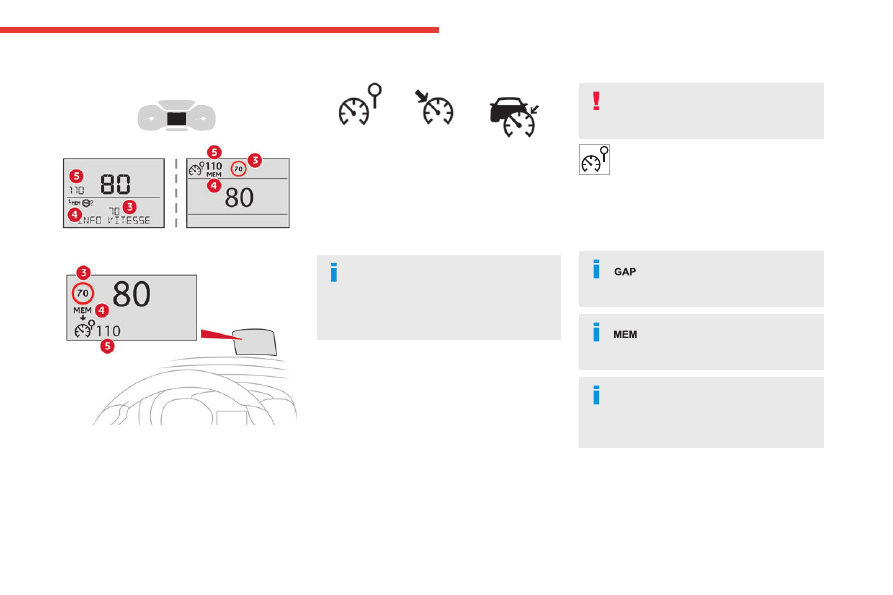
157
Driving
6
Information displayed on the
instrument panel
Head-up display
3.
Speed limit indication.
4.
Request to memorise the speed.
5.
Current speed setting.
Storing the speed setting
► Switch on the speed limiter/cruise control.
The speed limiter/cruise control information is
displayed.
Upon detecting a sign suggesting a new speed
setting, the system displays the value and
"
MEM
" flashes for a few seconds, prompting you
to save it as a new speed setting.
If there is a difference of less than 6 mph
(9 km/h) between the speed setting and
the speed displayed by the Road signs
recognition, the "
MEM
" symbol is not
displayed.
Depending on the road conditions, several
speeds may be displayed.
► Press button
2 once
to save the suggested
speed value.
A message is displayed, confirming the request.
► Press button
2 again
to confirm and save the
new speed setting.
The display then reverts to its previous state.
Speed limiter
For more information, refer to the
General recommendations on the use
of driving and manoeuvring aids
.
This system prevents the vehicle from
exceeding the speed programmed by the
driver (speed setting).
The speed limiter is switched on manually.
The minimum speed setting is 19 mph (30 km/h).
The speed setting remains in the system
memory when the ignition is switched off.
For more information on this
button and the
Adaptive cruise
control
, refer to the corresponding section.
For more information on
Memorising speeds
, refer to the
corresponding section.
For more information on
Speed limit
recognition
and memorising the speed
limit in particular, refer to the corresponding
section.
-------------------------------------------------------------------------------------------------------------------------------------------------------------
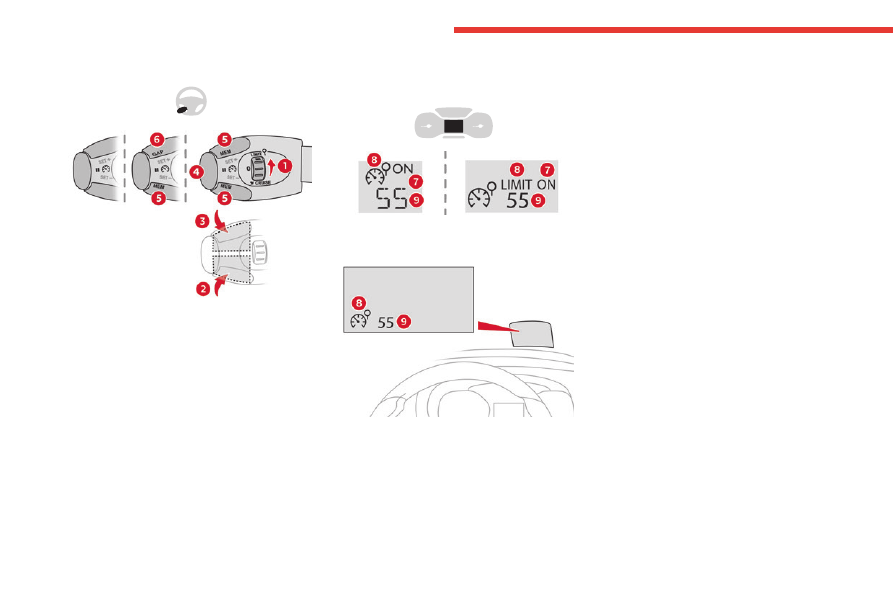
158
Driving
Steering-mounted control
1.
ON (
LIMIT
position)/OFF (position
0
)
2.
Reduce the speed setting
3.
Increase the speed setting
4.
Pause/resume speed limiter with the speed
setting previously stored
5.
Depending on version:
Display the speed thresholds saved using the
Memorising speeds function
or
Use the speed suggested by the Road signs
recognition function (
MEM
display)
6.
Display and adjustment of the programmed
inter-vehicle distance
For more information on
Memorising speeds
or the
Road signs recognition
, refer to the
corresponding sections.
Information displayed on
the instrument panel
Head-up display
7.
Speed limiter on/pause indication.
8.
Speed limiter mode selection indication.
9.
Speed setting value.
Switching on/Pausing
► Turn thumbwheel
1
to the "
LIMIT
" position
to select speed limiter mode; the function is
paused.
► If the speed limit setting is suitable (most
recent speed setting programmed in the system),
press button
4-II
to switch the speed limiter on.
► Pressing
4-II
again temporarily pauses the
function (pause).
Adjusting the limit speed
setting
You do not have to switch the speed limiter on in
order to set the speed.
To modify the limit speed setting based on the
vehicle’s current speed:
► For steps of +/- 1 mph (1 km/h), briefly
press
2-SET-
or
3-SET+
repeatedly.
► For steps of +/- 5 mph (5 km/h), press and
hold
2-SET-
or
3-SET+
.
To change the limit speed setting using
memorised speeds, via the touch screen:
► Press
5-MEM
to display the memorised
speed settings.
► Press the touch screen button for the desired
speed setting.
The selection screen closes after a few
moments.
This setting becomes the new limit speed.
To modify the speed limit setting based on the
speed suggested by the Road signs recognition
function displayed on the instrument panel:
► Press
5-MEM
once; a message is displayed,
confirming the memorisation request.
► Press
5-MEM
again to save the suggested
speed.
-------------------------------------------------------------------------------------------------------------------------------------------------------------

159
Driving
6
The new speed setting value is displayed on the
instrument panel.
Temporarily exceeding the
programmed speed
► To temporarily exceed the programmed
speed threshold, fully depress the accelerator
pedal.
The speed limiter is deactivated temporarily and
the displayed programmed speed flashes.
If it is exceeded for a prolonged period of time,
an audible warning is triggered.
Simply release the accelerator pedal to return to
below the programmed speed.
When the limit speed is exceeded but this is not
due to action by the driver (in case of a steep
slope, for example), an audible signal triggers
immediately.
Once the speed of the vehicle returns to the
programmed setting, the speed limiter functions
again: the display of the programmed speed
setting becomes fixed again.
Switching off
► Turn the thumbwheel
1
to the "
0
" position:
the display of information on the speed limiter
disappears.
Malfunction
In the event of a malfunction, dashes are
displayed flashing and then fixed instead of the
speed setting.
Have it checked by a CITROËN dealer or a
qualified workshop.
Cruise control - Specific
recommendations
The cruise control function does not
guarantee compliance with the maximum
authorised speed and the safety distance
between vehicles, the driver remains
responsible for their driving.
In the interest of public safety, only use cruise
control if the traffic conditions enable vehicles
to drive at a steady speed and maintain an
adequate safety distance.
Remain vigilant while cruise control is
activated.
If you press and hold one of the
speed setting modification buttons, your
vehicle may change speed very abruptly.
When
descending a steep hill
, the cruise
control system cannot prevent the vehicle
from exceeding the set speed. Brake if
necessary to control the vehicle speed.
On
steep climbs
or when towing, the set
speed may not be reached or maintained.
Exceeding the programmed speed
setting
You can
temporarily
exceed the speed
setting by pressing the accelerator pedal (the
programmed speed flashes).
To return to the speed setting, release the
accelerator pedal (when the set speed is
reached again, the displayed speed stops
flashing).
Operating limits
Never use the system in the following
situations:
– In an urban area with the risk of
pedestrians crossing the road.
– In heavy traffic.
– On winding or steep roads.
– On slippery or flooded roads.
– In poor weather conditions.
– In the event of restricted visibility for the
driver.
– Driving on a speed circuit.
– Driving on a rolling road.
– When using snow chains, non-slip covers
or studded tyres.
Cruise control
For more information, refer to the
General recommendations on the use
of driving and manoeuvring aids
and the
-------------------------------------------------------------------------------------------------------------------------------------------------------------
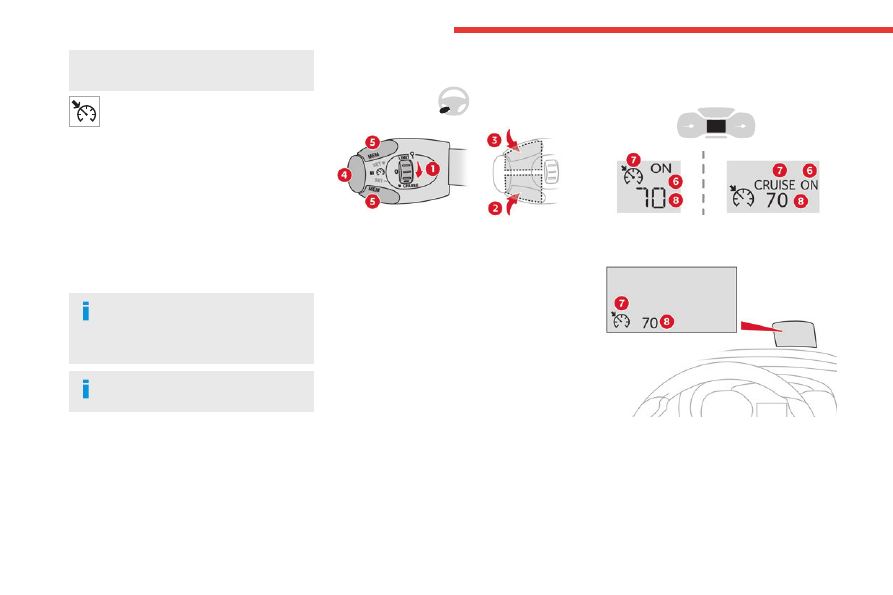
160
Driving
Cruise control - Specific
recommendations
.
This system automatically maintains the
vehicle’s speed at the value programmed
by the driver (speed setting), without the use of
the accelerator pedal.
Cruise control is switched on manually.
It requires a minimum vehicle speed of 25 mph
(40 km/h).
With a manual gearbox, third gear or higher must
be engaged.
With an automatic gearbox, mode
D
or second
gear or higher in mode
M
must be engaged.
With a drive selector, mode
D
or
B
must be
engaged.
Cruise control remains active after
changing gear, regardless of the gearbox
type, on engines fitted with the Stop & Start
function.
Switching off the ignition cancels any
speed setting.
Steering-mounted control
1.
ON (
CRUISE
position)/OFF (position
0
)
2.
Activate cruise control at the current speed/
decrease speed setting
3.
Activate cruise control at the current speed/
increase speed setting
4.
Pause/resume cruise control with the speed
setting previously saved
5.
Depending on version:
Display the speed thresholds saved using the
Memorising speeds function
or
Use the speed suggested by the Road signs
recognition function (
MEM
display)
For more information on
Memorising speeds
or the
Road signs recognition
, refer to the
corresponding sections.
Information displayed on
the instrument panel
Head-up display
6.
Cruise control pause/resume indication.
7.
Cruise control mode selection indication.
8.
Speed setting value.
Switching on/pausing
► Turn thumbwheel
1
to the "
CRUISE
" position
to select cruise control mode; the function is
paused.
-------------------------------------------------------------------------------------------------------------------------------------------------------------
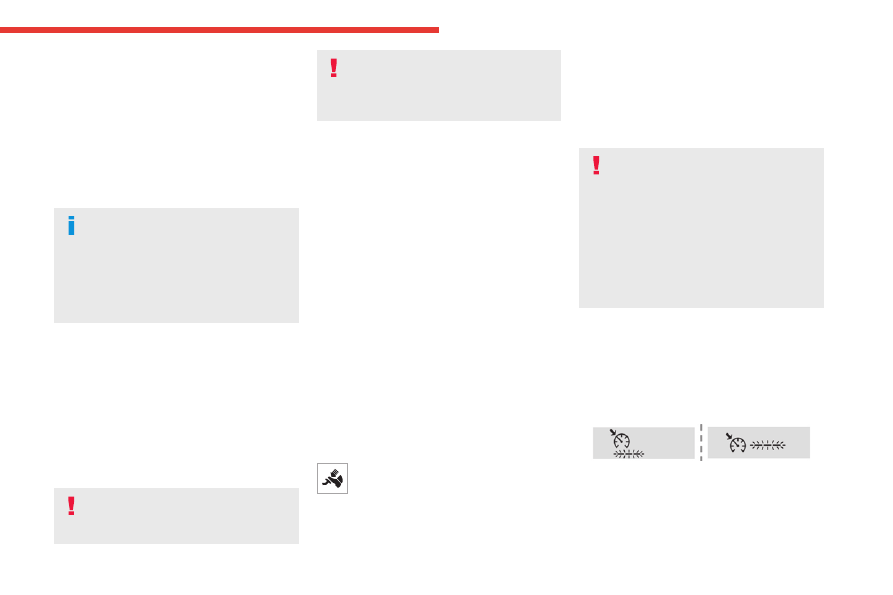
161
Driving
6
► Press button
2-SET-
or
3-SET+
to activate
cruise control and save a speed setting when
the vehicle has reached the desired speed; the
vehicle’s current speed is saved as the speed
setting.
► Release the accelerator pedal.
► Pressing button
4-II
temporarily pauses the
function (pause).
► Pressing button
4-II
again resumes operation
of the cruise control (ON).
Cruise control can also be paused
temporarily:
– by pressing the brake pedal.
– by pressing the clutch pedal with a manual
gearbox (depending on the engine fitted).
– automatically, if the electronic stability
control (ESC) system is triggered.
Changing the cruise speed
setting
The cruise control must be active.
To change the cruise speed setting, based on
the vehicle’s current speed:
► For steps of +/- 1 mph (1 km/h), briefly
press
2-SET-
or
3-SET+
repeatedly.
► For steps of +/- 5 mph (5 km/h), press and
hold
2-SET-
or
3-SET+
.
Pressing and holding
2-SET-
or
3-SET+
results in a rapid change in the speed of
the vehicle.
As a precaution, we recommend setting
a cruise speed fairly close to the current
speed of your vehicle, to avoid any sudden
acceleration or deceleration of the vehicle.
To change the cruise speed setting using
memorised speed settings and from the touch
screen:
► Press
5-MEM
to display the memorised
speed settings.
► Press the touch screen button for the desired
speed setting.
The selection screen closes after a few
moments.
This setting becomes the new cruise speed.
To change the cruise speed setting using the
speed suggested by the Road signs recognition
function displayed on the instrument panel:
► Press
5-MEM
once; a message is displayed,
confirming the memorisation request.
► Press
5-MEM
again to save the suggested
speed.
The new speed setting value is displayed on the
instrument panel.
Temporarily exceeding the
programmed speed
If needed (when overtaking, for example),
it is possible to exceed the programmed
speed by pressing the accelerator pedal.
Cruise control is temporarily deactivated and the
programmed speed displayed flashes.
To return to the programmed speed, simply
release the accelerator pedal.
Once the vehicle has returned to the
programmed speed, cruise control takes over
again and the programmed speed setting stops
flashing.
When descending a steep hill, the cruise
control system cannot prevent the
vehicle from exceeding the programmed
speed.
You may have to brake to control the speed of
your vehicle. In this case, the cruise control is
automatically paused.
To activate the system again, with the vehicle
speed above 25 mph (40 km/h), press button
4
.
Switching off
► Turn the thumbwheel
1
to the "
0
” position: the
cruise control information disappears from the
screen.
Malfunction
In the event of a malfunction, dashes are
displayed flashing and then fixed instead of the
speed setting.
Have it checked by a CITROËN dealer or a
qualified workshop.
-------------------------------------------------------------------------------------------------------------------------------------------------------------

Нет комментариевНе стесняйтесь поделиться с нами вашим ценным мнением.
Текст